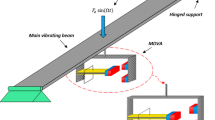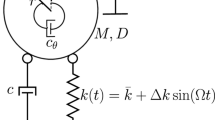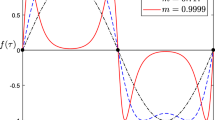Abstract
A novel semi-active vibration control concept with a serial-switch-stiffness-system was previously presented in our work. Differing from conventional vibration control systems, this system does not dissipate but converts vibration energy as potential energy stored in springs and then reacts against external disturbance. As a piecewise linear system, whether or not energy conversion limit happens is an interesting nonlinear dynamic issue related to the systems steady state response. This paper formulates this issue in depth using the approach called equivalence in control. The systems control force represented by the converted vibration energy is approximately decomposed into two portions. One is responsible for low-frequency free response and the other for high-frequency switching response. An equivalent linear system suffering from a decomposed high-frequency switching force is obtained instead of the original switched system. The steady state response of the disturbed system can be delivered through linear superposition as executed in a linear system. Energy conversion limit occurring in the system under a harmonic disturbance is numerically shown by means of fast Fourier transformation. Analytical formulation and numerical simulation for open- and closed-loop control of the system are further carried out, respectively. The results give that the proposed approach is capable of solving the stead state response of the switched system accurately, and meanwhile, energy conversion limit occurs in the vibration control system indeed. Experimental discussion is also executed.













Similar content being viewed by others
References
Nader, J.: A comparative study and analysis of semi-active vibration control systems. J. Vib. Acoust. 124(4), 593–605 (2002)
Kamali, S.H., Moallem, M., Arzanpour, S.: Realization of an energy-efficient adjustable mechatronic spring. IEEE/ASME Trans. Mechatron. 23(4), 1877–1885 (2018)
Opie, S., Yim, W.: Design and control of a real-time variable stiffness vibration isolator. In: Proceedings of IEEE/ASME, IEEE/ASME International Conference on Advanced Intelligent Mechatronics, pp. 380–385 (2009)
Winthrop, M.F., Bakerb, W.P., Cobba, R.G.: A variable stiffness device selection and design tool for lightly damped structures. J. Sound Vib. 287, 667–682 (2005)
Onoda, J., Endo, T., Tamaoki, H., Watanbe, N.: Vibration suppression by variable-stiffness members. AIAA J. 29, 977–983 (1991)
Leitmann, G.: Semi-active control for vibration attenuation. J. Intell. Mater. Syst. Struct. 5, 841–846 (1994)
Irie, T., Shingu, K.: Vibraion control of variable rigidity frame structure by magnetic clutch. J. Comput. Sci. Technol. 2(3), 393–400 (2008)
Leavitt, J., Bobrow, J.E., Jabbari, F.: Design of a 20000 pound variable stiffness actuator for structural vibration attenuation. Shock Vib. 2008(15), 687–696 (2008)
Cunefare, K.A., Rosa, S.D., Sadegh, N., Larson, G.: State-switched absorber for semi-active structural control. J. Intell. Mater. Syst. Struct. 11, 300–310 (2000)
Min, C., Dahlman, M., Sattel, T.: A concept for semi-active vibration control with a serial-stiffness-switch system. J. Sound. Vib. 405, 234–250 (2017)
Dahlman, M., Min, C., Sattel, T.: A note on a double-serial switch-spring-parallel semi-active connection element. In: The 88th Annual Meeting of the International Association of/Proceedings in Applied Mathematics and Mechanics, Germany (2017)
Min, C., Dahlman, M., Sattel, T.: Semi-active vibration reduction based on a sliding mode controlled serial-stiffness-switch system. In: The 89th Annual Meeting of the International Association of/Proceedings in Applied Mathematics and Mechanics, Germany (2018)
Min, C., Dahlman, M., Sattel, T.: A semi-active shock isolation concept with serial-stiffness-switch system. J. Sound. Vib. 445, 117–131 (2019)
Guinjoan, F., Calvente, J., Poveda, A., Martinez, L.: Large-signal modeling and simulation of switching DC–DC converters. IEEE Trans. Power Electron. 12(3), 485–494 (1997)
Davoudi, A., Jatskevich, J., De Rybel, T.: Numerical state-space average-value modeling of PWM DC–DC converters operating in DCM and CCM. IEEE Trans. Power Electron. 21(4), 1003–1012 (2006)
Ben-Yaakov, S.: Behavioral average modeling and equivalent circuit simulation of switched capacitors converters. IEEE Trans. Power Electron. 27(2), 632–636 (2013)
Maksimovic, D.: Computer-aided small-signal analysis based on impulse response of DC/DC. IEEE Trans. Power Electron. 15(6), 1183–1191 (2000)
Liou, M.L.: Exact analysis of linear circuits containing periodically operated switches with applications. IEEE Trans. Circuit Theory 19(2), 146–154 (1972)
Yuan, F., Opal, A.: Noise and sensitivity analysis of periodically switched linear circuits in frequency domain. IEEE Trans. Circuits Syst. I Reg. 47(7), 986–998 (2000)
Behjati, H., Niu, L., Davoudi, A., Chapman, P.L.: Alternative time-invariant multi-frequency modeling of PWM DC–DC converters. IEEE Trans. Circuits Syst. I Reg. 60(11), 3069–3079 (2013)
Trinchero, R., Manfredi, P., Stievano, I.S., Canavero, F.G.: Steady-state analysis of switching converters via frequency-domain circuit equivalents. IEEE Trans. Circuits Syst. II Exp. Br. 63(8), 748–752 (2016)
Min, C.: New Semi-active Vibration Control with Serial-Stiness-Switch-System Based on Vibration Energy Harvesting. Ph.D. thesis, Technischen Universitaet Ilmenau, Ilmenau, Germany (2018)
Acknowledgements
Funding was provided by Postdoctoral Research Foundation of China and Natural Science Foundation of Shanxi Province (Grant No. 2020JQ-048).
Author information
Authors and Affiliations
Corresponding author
Ethics declarations
Conflict of interest
The authors have not potential conflicts of interest.
Additional information
Publisher's Note
Springer Nature remains neutral with regard to jurisdictional claims in published maps and institutional affiliations.
Rights and permissions
About this article
Cite this article
Min, C., Dahlmann, M. & Sattel, T. Steady state response analysis for a switched stiffness vibration control system based on vibration energy conversion. Nonlinear Dyn 103, 239–254 (2021). https://doi.org/10.1007/s11071-020-06147-8
Received:
Accepted:
Published:
Issue Date:
DOI: https://doi.org/10.1007/s11071-020-06147-8




